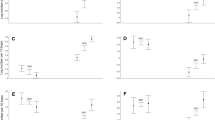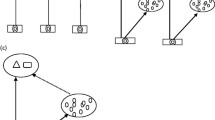Abstract
Mechanisms allowing the persistence of an aquatic predator-prey system in tiny pools (the mean ca. 0.5 ml) held by taro axils were analyzed from the viewpoint of temporal and spatial patterns of habitat use. Predatory larvae of a mosquitoTopomyia tipuliformis concentrated in young axils, while 9 other taxa utilized both young and old axils or concentrated more in older axils. The total prey density was lower in axils with the predator but the density of each prey taxon (except for a few cases) and the number of prey taxa did not differ between axils with and without predators. This indicates thatT. tipuliformis is a general predator and does not influence prey community organization through selective removal of particular prey taxa. Inter-axil distribution ofT. tipuliformis was aggregated in the first instar but uniform in the third and fourth instars due to intraspecific cannibalism, which assures the survival of a single individual under short food supply. Distributions of prey taxa were mostly aggregated, fitting the negative binomial distribution. Thirty seven out of 45 associations of 10 taxa were independent with 3 negative (between the predator and some late-colonizing prey) and 5 positive (between some prey taxa) associations. Probabilistic refuges (produced by independent aggregated distributions) reduced interspecific encounters which may result in competition and predation, and thus probably facilitated prey coexistence. There was no evidence for the importance of predation in structuring the prey community. This system may be prey-dominated in that predator persistence depends on prey community existence but prey community structure depends less on predation.
Similar content being viewed by others
References
Anscombe, F. J. (1950) Sampling theory of the negative binomial and logarithmic series distributions.Biometrika 37: 358–382.
Atkinson, W. D. and B. Shorrocks (1981) Competition on a divided and ephemeral resource: A simulation model.Journal of Animal Ecology 50: 461–471.
Beaver, R. A. (1979) Biological studies of the fauna of pitcher plantsNepenthes in West Malaysia.Annales de la Société Entomologique de France (Nouvelle Série) 15: 3–17.
Beaver, R. A. (1983) The community living inNepenthes pitcher plant: Fauna and food webs. pp. 129–154.In J. H. Frank and L. P. Lounibos (eds.)Phytotelmata: terrestrial plants as hosts for aquatic insect communities. Plexus Publishing, Medford, New Jersey.
Bliss, C. I. and R. A. Fisher (1953) Fitting the negative binomial distribution to biological data and note on the efficient fitting of the negative binomial.Biometrics 9: 239–256
Bradshow, W. E. and C. M. Holzapfel (1983) Predator-mediated, non-equilibrium coexistence of tree-hole mosquitoes in southeastern North America.Oecologia 57: 239–256.
Frank, J. H. (1983) Bromeliad phytotelmata and their biota, especially mosquitoes. pp. 101–159.In J. H. Frank and L. P. Lounibos (eds.)Phytotelmata: Terrestrial plants as hosts for aquatic insect communities. Plexus Publishing, Medford, New Jersey.
Frank, J. H. and G. A. Curtis (1977) On the bionomics of bromeliad-inhabiting mosquitoes. III. The probable strategy of larval feeding inWyeomyia vanduzeei andWy medioalbipes.Mosquito News 37: 200–206.
Frank, J. H. and L. P. Lounibos (eds.) (1983)Phytotelmata: Terrestrial plants as hosts for aquatic insect communities. Plexus Publishing, Medford, New Jersey.
Green, R. F. (1986) Does aggregation prevent competitive exclusion? A response to Atkinson and Shorrocks.American Naturalist 128: 301–304.
Hairston, N. G., F. E. Smith and L. B. Slobodkin (1960) Community structure, population control, and competition.American Naturalist 44: 421–425.
Hassell, M. P. (1979) The dynamics of predator-prey interactions: polyphagous predators, competing predators and hyperparasitoids. pp. 283–306.In R. M. Anderson, B. D. Turner and L. R. Taylor (eds.)Population dynamics. 20th Symposium of British Ecological Society. Blackwell, Oxford.
Hassell, M. P. and J. K. Waage (1984) Host-parasitoid population interactions.Annual Review of Entomology 29: 89–114.
Hurlbert, S. H. (1969) A coefficient of interspecific association.Ecology 50: 1–9.
Ives, A. R. and R. M. May (1985) Competition within and between species in a patchy environment: Relations between microscopic and macroscopic models.Journal of Theoretical Biology 115 65–92.
Kuno, E. (1986)Methods to study dynamics of animal populations I Kyoritsu Syuppan, Tokyo. (in Japanese).
Jaenike, J. and A. C. James (1991) Aggregation and the coexistence of mycophagousDrosophila.Journal of Animal Ecology 60: 913–928.
Lloyd, M. (1967) ‘Mean crowding”.Journal of Animal Ecology 36: 1–30.
Miyagi, I. and T. Toma (1989) A new species ofTopomyia (Suaymyia) suchariti from Thailand (Diptera; Culicidae).Mosquito Systematics 21: 16–24.
Miyagi, I., T. Toma and B. D. Cabrera (1983) Synonyms ofTopomyia rausai withTopomyia apsarae with description of the larva (Diptera; Culicidae).Mosquito Systematics 15: 111–116.
Mogi, M., M. Horio, I. Miyagi and B. D. Cabrera (1985) Succession, distribution, overcrowding and predation in the aquatic community in aroid axils, with special references to mosquitoes. pp. 95–119.In L. P. Lounibos, J. R. Rey and J. H. Frank (eds.)Ecology of mosquitoes: proceedings of a workshop. Florida Medical Entomology Laboratory, Vero Beach, Florida.
Mogi, M. and H. Suzuki (1983) The biotic community in the water-filled internode of bamboos in Nagasaki, Japan, with special reference to mosquito ecology.Japanese Journal of Ecology 33: 271–279.
Mogi, M. and H. S. Yong (1992) Aquatic arthropod communities inNepenthes pitchers: the role of niche differentiation, aggregation, predation and competition in community organization.Oecologia 90: 172–184.
Murdoch, W. W., J. Chesson and P. L. Chesson (1985) Biological control in theory and practice.American Naturalist 125: 343–366.
Naeem, S. (1988) Predator-prey interaction and community structure: chironomids, mosquitoes and copepods inHeliconia imbricata (Musaceae).Oecologia 77: 202–209.
Okazawa, T., M. Horio, H. Suzuki and M. Mogi (1986) Colonization and laboratory Bionomics ofTopomyia yanbarensis. (Diptera: Culicidae).Journal of Medical Entomology 23: 493–501.
Pacala, S. W. and Hassell, M. P. (1991) The persistence of host-parasitoid associations in patchy environments. II. Evaluation of field data.American Naturalist 138: 584–605.
Price, P. W. (1984)Insect ecology, 2nd ed. Wiley, New York.
Ramalingam, S. (1983)Topomyia houghtoni Feng, a new record in Malaysia and a redescription of the adult and immature stages.Mosquito Systematics 15: 33–40.
Ratliff, R. D. (1982) A correction of Cole's C7 and Hurlbert's C8 coefficients of interspecific association.Ecology 63: 1605–1606.
Rosewell, J., B. Shorrocks and K. Edwards (1990) Competition on a divided and ephemeral resource: Testing the assumptions. I. Aggregation.Journal of Animal Ecology 59: 977–1001.
Seifert, R. P. (1982) NeotropicalHeliconia insect communities.Quarterly Review of Biology 57: 1–28.
Shorrocks, B., W. Atkinson and P. Charlesworth (1979) Competition on a divided and ephemeral resource.Journal of Animal Ecology 48: 899–908.
Shorrocks, B., J. Rosewell and K. Edwards (1984) Interspecific competition is not a major organizing force in many insect communities.Nature 310: 310–312.
Sokal, R. R. and F. J. Rohlf (1981)Biometry. Freeman, San Francisco.
Southwood, T. R. E. (1978)Ecological methods. Chapman and Hall, London.
Steffan, W. A. and N. L. Evenhuis (1981) Biology ofToxyrhynchites.Annual Review of Entomology 26: 159–181.
Williamson, C. E. (1991) Copepoda. pp. 787–822.In J. H. Thorp and A. P. Lovich (eds.)Ecology and classification of North American freshwater invertebrates. Academic Press, San Diego.
Author information
Authors and Affiliations
Rights and permissions
About this article
Cite this article
Mogi, M., Sembel, D.T. Predator-prey system structure in patchy and ephemeral phytotelmata: Aquatic communities in small aroid axils. Res Popul Ecol 38, 95–103 (1996). https://doi.org/10.1007/BF02514975
Received:
Accepted:
Issue Date:
DOI: https://doi.org/10.1007/BF02514975




